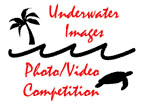Videolights
The Art of UW Video
Lighting
by Roger Roth
In a natural progression of our growth curve shooting UW video artistically, we will begin to recognize the need for quality lighting to bring out the colors in our shots. As successful UW cinematographers like Jean-Michel Cousteau have taught many of us, the three most important things in filming are lighting, lighting, and lighting. So this use of light becomes another artistic talent we need to develop.
Of course, some may argue that getting close, then closer, then even closer still might be a primary valid goal as well. Either way, the necessity of good light is imperative to a good shot, and being closer will utilize the available light in the most effective way. The more light you have illuminating your subject, the more color you will capture in your shots.
Initially, probably for cost reasons, many of us begin shooting uw video using ambient light. It doesn't take long to realize that we need to be constantly aware of where the sun is. As we swim around the reef, the sun position changes in relation to our own positions, so we need to feel and know where the sunlight is coming from at all times in order to be ready to use it effectively. If not given the chance to look for the sun because of something swimming by suddenly, paying attention to the shadows will also help ascertain where the sunlight is coming from, and allow movement to the best angle.
The sun needs to be coming over our shoulders and illuminating our subjects. Without this exact angle of the sun, we would be shooting the shadowed side of our subject. We might as well not even take the shot, as there will be little or no color in it, whether shooting upwards, straight on, or downwards to your subject.
Shots that aren't illuminated well are drab and will be noticeable when viewed next to bright and colorful shots. Flat shots will detract from any production. The only acceptable time to use dimmer shots would be when they are specifically meant to be silhouette shots.
This adds a new dimension to point and shoot, and precludes it as well. Now, every angle we attempt to get has to incorporate the sun (or video lights) effectively. Whether it's wide-angle shots or close-ups, this is the most important aspect of our talents, and will make or break every shot we take.
Considering artificial lighting, videographers should know that the beam of a regular night-light is too concentrated to use to light up a subject. If somebody is spotting with a regular night-light, whether day or night, it will cause a red hot spot on film. Asking our buddies to not keep their night-lights in the picture is a very prudent thing to do before the dives. Video lights are manufactured to have a more diffused light to a larger area.
The only time one might want a regular night-light in their video is when that light is pointing away from the camera into the blue with only a bit of it reaching the camera, or when a model points the light a little towards the camera and keeps it moving. They can be pretending to search for something in front of our camera. This does create a nice shot and adds one more moving piece to a video clip.
Those of us fortunate enough to have video light(s) learn that having those lights mounted directly on the camera will illuminate the backscatter in our shots, just as in still photography. Our lights need to be mounted on arms held away from our housings, then directed back towards the subject. This eliminates the direct reflection of the light on the particles between our subjects and the camera.
We quickly learn that when we use our lights, we also have to remember to remove our color correction filters, unless a blue filter is added to the lens of our lights. The lights without a blue filter bring out the same color as our red color correction filters do, thus doubling the effect. The combination of the two will ruin every shot, leaving it quite red. Fortunately these days, this can be pretty well corrected on the computer, but just causes more work in post-production.
If using one light, we have to consider where we want the light coming from to best illuminate our subjects. Naturally, a choice to come from above will simulate real sunlight. But another option is to illuminate from below, which might also pick up some very nice colors in a nearby coral or sponge under the subject that would normally be shadowed. With any choice, we must be close enough to our subject, or darker unlit areas will be evident in the picture.
When using two lights, where we point those lights is of utmost importance. Pointing the lights directly at our subject will many times cause a bright white hot spot in our video (especially when using HID lights). Not pointing the lights close enough to our subjects will result in poor illumination or may even show two separate circles of light.
The best results using two lights will usually be reached by pointing each light to their respective sides of the subject, allowing the peripheral edges of each beam to overlap in the middle onto the subject. With a little practice, it's not too difficult to ascertain just how far away to point the lights. On a night dive, it is easier to see the overlapping area, so this might be a good time to begin experimenting.
Now, what about some different effects with our lighting? Just as in still photography, illuminating the foreground can add an interesting type of shot not normally seen in most video productions. Even if our main subject is farther away than our lights will reach, if in shallower water, we can use the natural sunlight to color our subject while the foreground is lit with our video lights. This same foreground lighting can help create a very nice silhouette shot with a diver far behind, too!
One last interesting suggestion is to have one or two buddies use a single light from the side(s). This can be used as the only illumination on a night dive and makes it seem like the viewer is actually watching divers spot things. Using extra hand-held lights can also augment our mounted video lights, brightening things in the background that our own lights may not be able to reach. Sea Ya!
Critter corner: When night diving in an area with many basket stars around, search for them using ambient light only. Once you find a nice one totally opened up, turn on your video camera then your lights, and shoot it as it folds in on itself from the light, thinking it's dawn!
copyright © Roger Roth, 2002 - 2011
Roger Roth is a roofer by trade and lives in Cincinnati, Ohio. But his passion is underwater videography and after several decades of learning how to shoot and edit he has evolved into a teacher and a photographic philanthropist. Roger is the founder of the annual international Underwater Images Photo and Video Competition. You may contact Roger at rroth2@cinci.rr.com.

